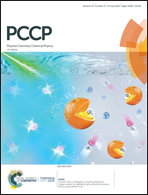Effect of toxic ligands on O2 binding to heme and their toxicity mechanism†
Abstract
Heme, as the cofactor and active site of Hb, enables Hb to carry out the necessary function required for O2 management for life, that is, reversible O2 binding for transport. In this paper, the microscopic mechanism of heme-associated poisoning has been elucidated from the perspective of electronic interaction by performing first-principles calculations. The results show that the functional groups (–CHO, –COOH, –NO2, –NH2) and CN exhibit a stronger affinity for heme than O2 and are more likely to occupy the O2 binding site, which results in the loss of the ability of heme to carry O2. Moreover, the addition of functional groups, CO and CN to heme at the side site can cause a pronounced enhancement toward the O2 binding characteristics of heme, which prevents heme from releasing O2 to oxygen-consuming tissues as the blood circulates. The reversible O2 binding function of heme is disrupted by the presence of these toxic ligands in the heme binding pocket, which greatly affects O2 transport in the blood. The inability of tissues to obtain O2 leads to tissue hypoxia, which is the main cause of poisoning. Based on the energy, geometry and electronic properties, the hypoxia mechanism proposed by us coincides well with experiment, and the research has the potential to provide a theoretical reference for the relevant areas of bioscience.



 Please wait while we load your content...
Please wait while we load your content...